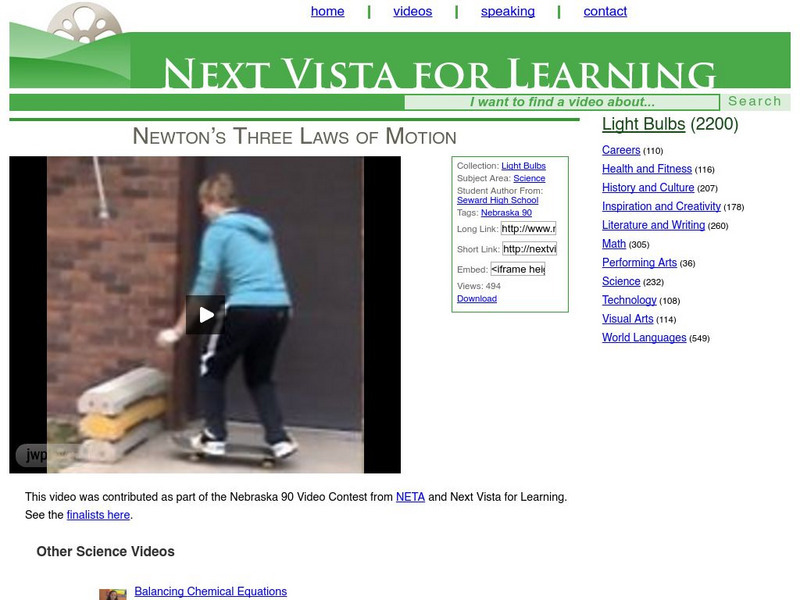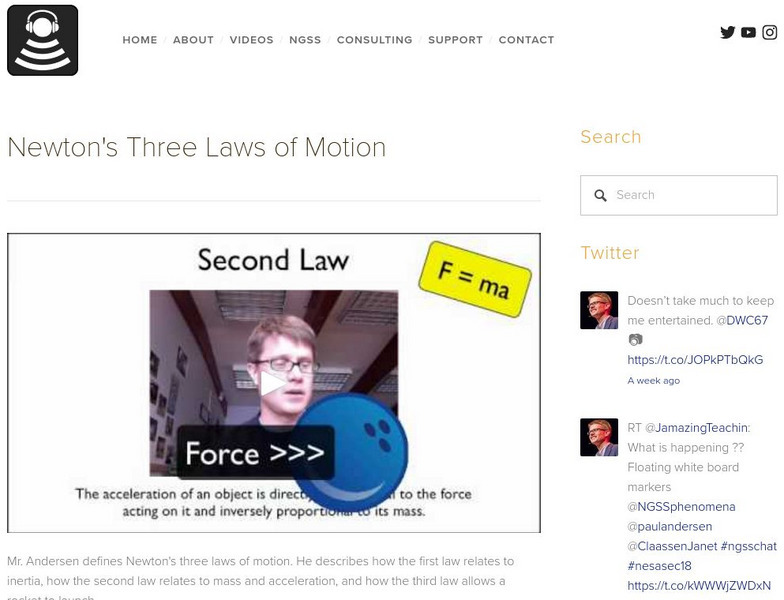Khan Academy
Khan Academy: Acceleration Due to Gravity at the Space Station
A video exploring the acceleration due to gravity at the space station. [10:12]
Next Vista for Learning
Next Vista for Learning: Newton's Laws of Motion
A video explaining Newton's Laws of Motion. Laws are defined with examples to help students understand the law. [1:38]
Next Vista for Learning
Next Vista for Learning: Newton's Three Laws of Motion
Review Newton's Laws with this short video which explains the laws and shows an example of each. [1:00]
Science for Kids
Science Kids: Physics Videos: Newton's Three Laws of Motion
This informative video will explore Newton's Three Laws of Motion. Learn how objects move, stay moving, and stop according to these laws. [11:39]
Sophia Learning
Sophia: Equilibrium & Moving Objects: Lesson 2
This lesson explains how moving objects can also be in mechanical equilibrium. It is 2 of 2 in the series titled "Equilibrium & Moving Objects."
Sophia Learning
Sophia: Equilibrium & Moving Objects: Lesson 1
This lesson explains how moving objects can also be in mechanical equilibrium. It is 1 of 2 in the series titled "Equilibrium & Moving Objects."
Sophia Learning
Sophia: Equilibrium & Stationary Objects: Lesson 2
This lesson demonstrates how mechanical equilibrium is related to stationary objects. It is 2 of 2 in the series titled "Equilibrium & Stationary Objects."
Sophia Learning
Sophia: Equilibrium & Stationary Objects: Lesson 1
This lesson demonstrates how mechanical equilibrium is related to stationary objects. It is 1 of 2 in the series titled "Equilibrium & Stationary Objects."
Sophia Learning
Sophia: Finding Net Force: Lesson 2
This lesson demonstrates how to find the net force acting on an object. It is 2 of 2 in the series titled "Finding Net Force."
Sophia Learning
Sophia: Finding Net Force: Lesson 1
This lesson demonstrates how to find the net force acting on an object. It is 1 of 2 in the series titled "Finding Net Force."
Sophia Learning
Sophia: Force & Acceleration: Lesson 2
This lesson explains why force and acceleration are directly proportional. It is 2 of 2 in the series titled "Force & Acceleration."
Sophia Learning
Sophia: Forces in a Rope & Pulley System: Lesson 1
This lesson explains what forces are acting on objects which are at rest or moving in a rope and pulley system. It is 1 of 2 in the series titled "Forces in a Rope & Pulley System."
Sophia Learning
Sophia: Force & Vectors: Lesson 2
This lesson explain why force is considered a vector. It is 2 of 2 in the series titled "Force & Vectors."
Sophia Learning
Sophia: Force & Vectors: Lesson 1
This lesson explain why force is considered a vector. It is 1 of 2 in the series titled "Force & Vectors."
Sophia Learning
Sophia: Friction & Net Force: Lesson 2
This lesson explains how friction is part of the net force acting on an object. It is 2 of 2 in the series titled "Friction & Net Force."
Sophia Learning
Sophia: Galileo's Inclined Planes: Lesson 1
This lesson introduces the concept of inertia and explains how Galileo Galilei used inclined planes to develop the concept of inertia. It is 1 of 2 in the series titled "Galileo's Inclined Planes."
Sophia Learning
Sophia: Introduction to Tension: Lesson 2
This lesson introduces the concept of tension. It is 2 of 2 in the series titled "Introduction to Tension."
Sophia Learning
Sophia: Force & Acceleration: Lesson 1
This lesson explains why force and acceleration are directly proportional. It is 1 of 2 in the series titled "Force & Acceleration."
Sophia Learning
Sophia: Forces & Motion: Lesson 1
This lesson explains how forces affect the motion of objects. It is 1 of 2 in the series titled "Forces & Motion."
Sophia Learning
Sophia: Friction & Net Force: Lesson 1
This lesson explains how friction is part of the net force acting on an object. It is 1 of 2 in the series titled "Friction & Net Force."
Science Friday Initiative
Science Friday: Teaching Newton's Laws Through Rhyme
Science teacher Christopher Emdin knows how to get his students interested in science: Rap about it.
Bozeman Science
Bozeman Science: Newton's Three Laws of Motion
Mr. Andersen defines Newton's three laws of motion. He describes how the first law relates to inertia, how the second law relates to mass and acceleration, and how the third law allows a rocket to launch.
Sophia Learning
Sophia: Bill Nye Answers: How Do You Remember Newton's Laws of Motion?
Take a look at this video from Bill Nye the Science Guy to see how to remember Newton's Laws of Motion. [1:08]






















